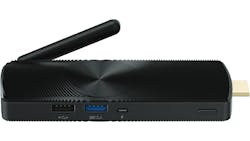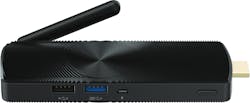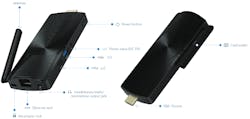PCs continue to get smaller. Eventually, they may wind up in the connector housing like USB 3 controllers. Compact units like Intel’s Next Unit of Computer (NUC) platforms are the smallest configurable platforms these days, with the ability to select the amount of RAM (in the form of SODIMMs) and storage (in the form of M.2 flash memory drives). They are designed to run standard operating systems like Windows 10 and Linux.
There is also a smaller, less expensive class of PC platforms called PC sticks. I had a chance to check out Azulle’s Access Plus, a fanless mini PC stick (Fig. 1). The Access Plus handles USB 3.0 peripherals like high-speed external disk drives, but it has a fixed amount of on-board RAM and flash storage.
The Access Plus comes in a $119 version with 2 Gbytes of RAM and 32 Gbytes of flash storage. The $159 version doubles the amount of RAM. It comes with Windows 10 installed and can run Ubuntu as well. I tried the former but recommend the latter.
The system supports Intel HD Graphics Card (gen 8) to drive the HDMI, 1080p output. These systems are designed to plug directly into an HDMI socket on an HDTV or monitor.
The 32 Gbyte of flash is sufficient for many applications but there are three alternatives for getting more non-volatile storage. One is the USB 3 interface. The next option is the Micro SDXC card slot that supports up to 128 Gbytes of storage. Finally, there is network- or cloud-based storage.
The system actually has a pair of USB sockets, not including the one that is used to provide power (Fig. 2). The latter is handy since it uses a standard USB power supply. The second USB socket is for USB 2 so it is more applicable to peripherals like a keyboard or mouse. Of course, a Bluetooth keyboard and mouse would be better, and the system supports that as well. The Access Plus supports Bluetooth 4.0 as well as dual-band Wi-Fi. For those like me who prefer a wired connection, the Access Plus also has a gigabit Ethernet interface.
Audio output will normally be done using the HDMI connection but, just in case, the Access Plus has a headphone/microphone jack. There is also a Kensington lock socket. The lock should be sufficient to keep the unit from being removed from a display, but not necessarily disconnected. This level of security may be sufficient for applications such as schools.
The Access Plus can be used almost anywhere and it is sufficiently mobile to take on a trip. Of course, a keyboard or mouse would be needed. I have a folding Bluetooth keyboard and small mouse that works well with it. Likewise, an HDMI port is needed but these days it is the rule rather than the exception for flat panel displays. It is easy enough to move that I only have one for the few HDTVs I have at home.
The Access Plus will not replace my gaming machine with water cooling and PCI Express GPU and multiple monitors, but it’s quite handy for the large-screen HDTV that used to have a Google Chromecast attached.
I found the Access Plus to be quite useful. Just remember while traveling to take it with you when you leave. Having a USB 3 hard drive attached is a good reminder.
About the Author
William G. Wong
Senior Content Director - Electronic Design and Microwaves & RF
I am Editor of Electronic Design focusing on embedded, software, and systems. As Senior Content Director, I also manage Microwaves & RF and I work with a great team of editors to provide engineers, programmers, developers and technical managers with interesting and useful articles and videos on a regular basis. Check out our free newsletters to see the latest content.
You can send press releases for new products for possible coverage on the website. I am also interested in receiving contributed articles for publishing on our website. Use our template and send to me along with a signed release form.
Check out my blog, AltEmbedded on Electronic Design, as well as his latest articles on this site that are listed below.
You can visit my social media via these links:
- AltEmbedded on Electronic Design
- Bill Wong on Facebook
- @AltEmbedded on Twitter
- Bill Wong on LinkedIn
I earned a Bachelor of Electrical Engineering at the Georgia Institute of Technology and a Masters in Computer Science from Rutgers University. I still do a bit of programming using everything from C and C++ to Rust and Ada/SPARK. I do a bit of PHP programming for Drupal websites. I have posted a few Drupal modules.
I still get a hand on software and electronic hardware. Some of this can be found on our Kit Close-Up video series. You can also see me on many of our TechXchange Talk videos. I am interested in a range of projects from robotics to artificial intelligence.




